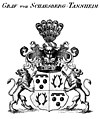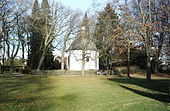Schaesberg (noble family)
Schaesberg is the name of the Lower Rhine noble family that the Limburg comes nobility and in 1706 by Emperor Joseph I in the imperial counts was charged. In 1712 his property, the rule of Kerpen and Lommersum , was raised to the status of an imperial immediate county, and the family was therefore introduced into the Westphalian Counts' College in 1715 . It counts to the high nobility .
history
Lords of Schaesberg
The original, noble-free family of Schaesberg ( Scoesberch, Schoitzberg, Schaefsberg ) was first mentioned in 1239 and was derived from the von Haesdal family, as was the coat of arms similar to that of Schönforst . The von Haesdal descended from Heinrich von Wassenberg (1151-1214), a son of Duke Heinrich III. from Limburg . Heinrich von Wassenberg's son Goswin von Wassenberg (approx. 1194 to 1264) became lord of Haasdal in 1217 (near Schimmert in today's municipality of Beekdaelen in the Dutch province of Limburg ); his fourth son Alard von Haesdal († 1265) had a younger son Hendrik (approx. 1223 - before 1265), who became lord of Schaesberg and Gronsveld . His older son was Gerhard I von Schaesberg (* approx. 1237), whose sons were Heinrich, Johann and Alard von Schaesberg, while Gerhard's younger brother Johann (* approx. 1250 - † 1326) founded the later Counts of Gronsveld . The lords of Schaesberg died out around 1410 and the lords of Retersbeck inherited their rule.
Schaesberg Castle , Netherlands
Counts of Schaesberg (of the Retersbeck tribe)

The later noble house of Schaesberg comes from the knightly family of Retersbeck (also: Reitersbach ), today Retersbeek, a district of Voerendaal . Wenemar de Retersbeke entered the military service of the city of Cologne in 1290. His brother Johann acknowledged the payment received to the city in 1291. The family then appears on October 8, 1334 with the squire Gerrit von Retersbeck . In 1335 Walram van Retersbeek is enfeoffed with Retersbeek by the Count of Geldern. The trunk series begins around 1381 with Wilhelm von Retersbeck called von Kaldenborn .
Wilhelm II von Retersbeck († before March 8, 1427) received permission from the Aachen city council on June 1, 1406 to draw water from the fountain at the fish market. It appeared in a document from 1405-1425 and from around 1410 was called "von Retersbeck called von Schaesberg" ( van Retersbeke, otherwise genoemd van Schoetsberch or van Rietersbeck, called van Schaisberch ). In 1415 he sealed the union of the duchies of Brabant, Limburg and Luxembourg under Duke Anton . The name Retersbeck gradually faded into the background - only the deer antlers in the combined coat of arms remind of him. The reason for the name change was the extensive Schaesberg property, which had come to the Retersbeck through inheritance, because Wilhelm's sister Gertrud was with Konrad II. Von Schaesberg and Johann III. von Schaesberg married, but both marriages remained childless, so that Wilhelm inherited the Schaesberg rule from his brothers-in-law. Further lines of those from Retersbeck took on other surnames, such as van Nutte , Nüth or Laar .
Wilhelm's descendant Johan von Schaesberg rebuilt Schaesberg Castle into a moated castle in the Renaissance style around 1570 . His son Frederik († 1619) was one of the richest noblemen in what was then Heerlen . Philip II of Spain thanked him for his services to the Spanish crown and the House of Habsburg by letting him freely dispose of his land and goods, which in 1618 became an independent hereditary rule of Schaesberg, which came from the moated castle and those that were added later Höfen Kackert, Leenhof, Scheyd and Palemig existed. From around 1600 the property was no longer a Brabantian fief , but an allod . Frederik's son Johan Frederik became a baron and was able to expand his possessions through lucrative marriages. He expanded Schaesberg Castle around 1650 with a new wing, an imposing corner tower and an estate. The von Schaesbergs, who were raised to imperial counts from 1706, lived in the moated castle until the 18th century. After that it gradually fell into disrepair, but was only expropriated by the Dutch state as German enemy property without compensation in 1945 because the Counts of Schaesberg had moved to Tannheim in Baden-Württemberg since the Reichsdeputationshauptschluss .
Johann Friedrich von Schaesberg (* December 21, 1598; † 1671), baron since 1637 , was a Neuburg treasurer , councilor and bailiff of Brüggen and steward of the Duchy of Jülich. His marriage on February 19, 1623 with Fernanda von Wachtendonck († August 29, 1644) brought the Krickenbeck Castle in Nettetal to the von Schaesberg, an old seat between Maas and Niers , which had come to Geldern in 1326 and which was in the 18th century became the main residence of the Schaesbergs. The historic aristocratic residences Haus Langenfeld in Wachtendonk-Wankum and Haus Bey also belonged to the extensive property .
In 1710 the rule of Kerpen and Lommersum were transferred to the Duchy of Jülich, which had in the meantime fallen to Pfalz-Neuburg . Duke Johann Wilhelm transferred the rulership to his minister, Count Schaesberg, which two years later became an imperial county. The imperial immediacy that was achieved in 1786 did not last long, however, as the territory was occupied by France as early as 1795. Of the former Kerpen Castle , only the castle hill still exists, because the last imperial count of Schaesberg zu Kerpen and Lommersum wanted to build a castle instead of the castle ruins, but could not get it because of the French occupation.

For the loss of imperial immediacy due to the annexation of the knightly canton of Lower Rhine by French revolutionary troops , Count Richard von Schaesberg was assigned the rule of Tannheim in Upper Swabia at the Reichsdeputationshauptschluss in 1803 , which until then had belonged to the now secularized Benedictine Abbey of Ochsenhausen as the maintenance office . In connection with the formation of the Confederation of the Rhine , the new rich county was immediate, however, in 1806 with intermediaries and came as civil rule under the supremacy of the Duchy of Württemberg , as such. B. the Swabian imperial county Isny , which in 1803 was assigned to the Counts of Quadt , also from the Lower Rhine, as secularized church property . The Ochsenhauser Pflegehof , also known as the Old Palace, was built between 1696 and 1698 and has been the main residence of the Counts of Schaesberg since 1623, who have also been landowners in Krickenbeck (with Bey) since 1623 and at the Schöller estate in Wuppertal since 1697 .
coat of arms
The Retersbeck family originally had red deer antlers in gold, which were repeated on the helmet with red and gold covers. The original von Schaesberg had three red balls in a silver field and a blue tournament collar above them . The coat of arms of the Retersbeck called Schaesberg was later quartered and supplemented in the first and fourth fields by the ball coat of arms of the Schaesberg. On the helmet with its red and silver covers there is a natural peacock's tail, which was the main coat of arms ornament of the original von Schaesberg.
Window with the family coat of arms, Krickenbeck Castle
Count of Schaesberg-Tannheim in Tyroff's book of arms
According to the coat of arms, the family seems to have the same origin as those of Dobbelstein.
people
Walram (1335) and Wilhelm I carried the name Schaesberg or Schafsberg and Retersbeck. It was not until Wilhelm II of Rettersbeck that he named himself Schaesberg in 1420.
- Wilhelm II of Retersbeck (named von Schaesberg in 1420)
- Friedrich I. von Schaesberg (gnt 1453–1472)
- Wilhelm IV of Schaesberg (last gnt in 1534)
- Jorrys von Schaesberg († May 17, 1562)
- Johann von Schaesberg († June 28, 1579)
- Friedrich II. Von Schaesberg († June 21, 1619)
- Johann Friedrich Freiherr von Schaesberg (* December 21, 1598 - † February 17, 1671), court master of the Duchy of Jülich, acquirer of the ancestral castle Krickenbeck
- Wolfgang Wilhelm von Schaesberg (born June 9, 1633 - † September 29, 1691)
- Johann Friedrich II Wilhelm von Schaesberg (* 1663 or 1664; † August 18, 1723 in Düsseldorf )
- Johann Wilhelm von Schaesberg (born November 22, 1696 - † November 5, 1768)
- Johann Friedrich von Schaesberg (June 10, 1705 - September 5, 1775)
- August Joseph Maria von Schaesberg (born October 24, 1730 - † February 9, 1801 in Düsseldorf)
- Franz Ferdinand von Schaesberg (January 8, 1733 - August 31, 1759 in Düsseldorf)
- Karl Franz von Schaesberg (May 27, 1734 - January 25, 1800)
- Richard Martin Maria von Schaesberg (born July 14, 1778 at Krickenbeck Castle , † March 24, 1856 in Kirchhellen )
- Rudolf von Schaesberg (1816–1881), German manor owner and administrative officer
- Richard von Schaesberg-Tannheim (1884–1953), German eventing rider
- Heinrich Wilhelm Viktor Walter Hubertus Maria Graf von Schaesberg – Thannheim (* February 12, 1922 in Berlin; † January 22, 1996 in Tannheim)
- Johannes Friedrich Walter Alfred Josef Maria Graf von Schaesberg (born October 22, 1960 in Munich)
literature
- Ernst Tode: Chronicle of the Retersbeck-Schaesberg. Starke, Görlitz 1918, p. 256
- Leo Peters : History of the sex from Schaesberg to mediatization. A contribution to the exploration of the inter-territorial ties of the Rhine-Maasland nobility . Ed .: Johannes Erbgraf von Schaesberg. Verlag der Buchhandlung Matussek, Nettetal 1990, ISBN 3-920743-19-9 , p. 308 .
- Genealogisches Handbuch des Adels , Adelslexikon Volume XII, Volume 125 of the complete series. CA Starke Verlag , Limburg (Lahn) 2001, ISSN 0435-2408 , pp. 312-314
Web links
- Genealogy of the Schaesberg house part 1
- Genealogy of the Schaesberg house part 2
- Archive of the Counts of Schaesberg (inventory list)
Individual evidence
- ↑ a b c Genealogical Handbook of the Nobility , Princely Houses Volume XV, Volume 114 of the complete series, Limburg ad Lahn 1997, p. 358
- ^ A b Genealogical-Historical-Statistical Almanac , Volume 8, Landes-Industrie-Comptoir, 1831, p. 328 ( Google Books )
- ↑ a b Jan GM Notten: Lijst van monialen in het Norbertinessenklooster van Sint-Gerlach te Houthem, circa 1202–1600 .
- ↑ a b Anton Fahne : History of the Cologne, Jülich and Bergisch families in family tables, coats of arms, seals and documents . Heberle, Cologne 1848, urn : nbn: de: hbz: 061: 1-77394
- ↑ a b c d Hermann Friedrich Macco : Aachen coat of arms and genealogies . Volume 2. Aachen 1907, p. 87 f.
- ^ Günter Aders: Regesten from the archives of documents of the dukes of Brabant . In: Düsseldorfer Jahrbuch , 44, 1974, p. 62
- ↑ To Walram van Retersbeek
- ↑ Oude stukken mbt family van / from Schaesberg . ( Memento of the original from April 13, 2014 in the Internet Archive ) Info: The archive link was inserted automatically and has not yet been checked. Please check the original and archive link according to the instructions and then remove this notice. Het digital gougen van kasteel Schaesberg, accessed July 30, 2013
- ↑ Emiel Ramakers: De Schaesbergse erfenis . In: Adel aan Maas, Roer en Geul , deel I (2009)
- ↑ a b A. Flag: p. 376










